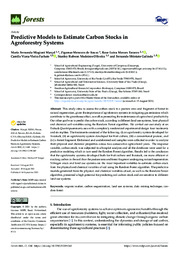Deep learning architectures for semantic segmentation and automatic estimation of severity of foliar symptoms caused by diseases or pests.
Deep learning architectures for semantic segmentation and automatic estimation of severity of foliar symptoms caused by diseases or pests.
Author(s): GONÇALVES, J. P.; PINTO, F. A. C.; QUEIROZ, D. M.; VILLAR, F. M. M.; BARBEDO, J. G. A.; DEL PONTE, E. M.
Summary: Colour-thresholding digital imaging methods are generally accurate for measuring the percentage of foliar area affected by disease or pests (severity), but they perform poorly when scene illumination and background are not uniform. In this study, six convolutional neural network (CNN) architectures were trained for semantic segmentation in images of individual leaves exhibiting necrotic lesions and/or yellowing, caused by the insect pest coffee leaf miner (CLM), and two fungal diseases: soybean rust (SBR) and wheat tan spot (WTS). All images were manually annotated for three classes: leaf background (B), healthy leaf (H) and injured leaf (I). Precision, recall, and Intersection over Union (IoU) metrics in the test image set were the highest for B, followed by H and I classes, regardless of the architecture. When the pixel-level predictions were used to calculate percent severity, Feature Pyramid Network (FPN), Unet and DeepLabv3+ (Xception) performed the best among the architectures: concordance coefficients were greater than 0.95, 0.96 and 0.98 for CLM, SBR and WTS datasets, respectively, when confronting predictions with the annotated severity. The other three architectures tended to misclassify healthy pixels as injured, leading to overestimation of severity. Results highlight the value of a CNN-based automatic segmentation method to determine the severity on images of foliar diseases obtained under challenging conditions of brightness and background. The accuracy levels of the severity estimated by the FPN, Unet and DeepLabv3 + (Xception) were similar to those obtained by a standard commercial software, which requires adjustment of segmentation parameters and removal of the complex background of the images, tasks that slow down the process.
Publication year: 2021
Types of publication: Journal article
Keywords: Aprendizado de máquina, Aprendizado profundo, Artificial intelligence, Convolutional neural network, Doença de Planta, Fitopatometria, Image segmentation, Inteligência artificial, Machine learning, Neural networks, Phytopathometry, Plant diseases and disorders, Rede neural convolucional, Segmentação de imagem
Observation
Some of Embrapa's publications are published as ePub files. To read them, use or download one of the following free software options to your computer or mobile device. Android: Google Play Books; IOS: iBooks; Windows and Linux: Calibre.
Access other publications
Access the Agricultural Research Database (BDPA) to consult Embrapa's full library collection and records.
Visit Embrapa Bookstore to purchase books and other publications sold by Embrapa.

